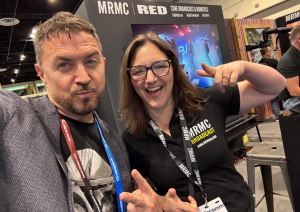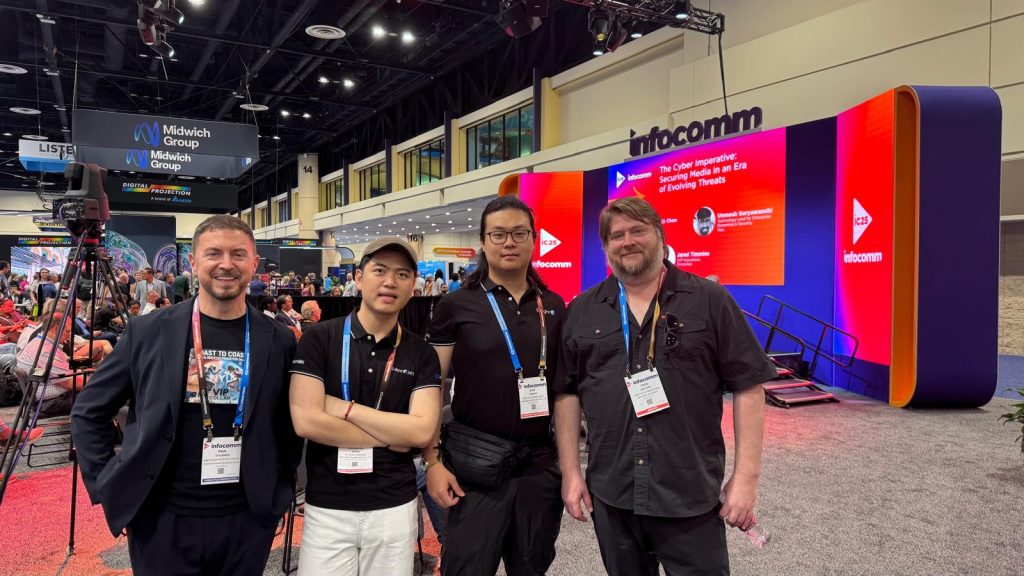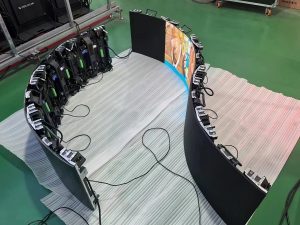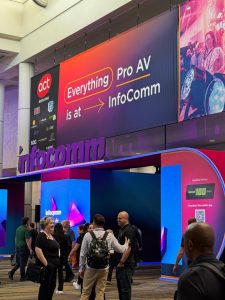The Future of Experience at InfoComm 2025
Every year, the audiovisual industry converges to answer a fundamental question: what’s next? At HOLODECK LED, we were thrilled to be on the ground, connecting with partners and showcasing our latest innovations including the TOTEM™ STAX and the Podium™ VJ Booth.
InfoComm is more than a trade show; it’s a living barometer of technological evolution and a crystal ball for the future of human interaction. InfoComm 2025 in Orlando was no exception. Amidst the dazzling displays and groundbreaking product launches, a clear and powerful narrative emerged: the era of passive viewing is over. The future of communication, branding, and entertainment is being built on the bedrock of immersive, multi-sensory experiences.
But beyond our excitement, the event provided a crucial opportunity to analyze the macro-trends shaping our industry. From the trade show floor to the educational sessions, three core pillars of this experiential future came into sharp focus: the cognitive science of attention, the rise of “phygital” spaces, and the surprising new frontiers of display technology such as MicroLED-in-Package (MIP).
In this blog, we will deconstruct these trends, moving beyond the buzz to explore the science, data, and strategic thinking that will define the next chapter of the AV industry.
The Neuroscience: Why Experiential Marketing Hijacks the Brain
For decades, marketing has been a battle for attention. Today, that battle has shifted from the airwaves to the amygdala. Modern marketing is no longer about reaching eyeballs; it’s about creating memories. This is the domain of experiential marketing, a strategy grounded in the fundamental principles of cognitive neuroscience.
 When an individual participates in a brand activation, they are not merely a passive recipient of a message. Their brain is actively engaged in a process of sensory integration, emotional response, and memory encoding. A study published in the Journal of Advertising Research found that experiences that engage multiple senses create more robust and durable memories than purely visual or auditory stimuli. This phenomenon, known as multisensory marketing integration, is a powerful tool for brands. When a potential customer can see, hear, and sometimes even touch a brand’s story, the neural pathways created are significantly stronger.
When an individual participates in a brand activation, they are not merely a passive recipient of a message. Their brain is actively engaged in a process of sensory integration, emotional response, and memory encoding. A study published in the Journal of Advertising Research found that experiences that engage multiple senses create more robust and durable memories than purely visual or auditory stimuli. This phenomenon, known as multisensory marketing integration, is a powerful tool for brands. When a potential customer can see, hear, and sometimes even touch a brand’s story, the neural pathways created are significantly stronger.
This is why a physical event like InfoComm remains so potent. It’s a multisensory environment by nature. The tactile feedback of a well-engineered locking mechanism on a rental panel, the visual impact of a perfectly calibrated video wall, the ambient sound of innovation—it all contributes to a deeper level of cognitive processing.

Furthermore, experiential marketing leverages the brain’s novelty bias. Our brains are hardwired to pay special attention to new and unexpected stimuli. As detailed by researchers at the University College London’s Institute of Cognitive Neuroscience, novel experiences trigger the release of dopamine, a neurotransmitter associated with pleasure and memory formation. A unique, interactive booth or a surprising visual display doesn’t just attract attention; it chemically primes the attendee’s brain to remember the interaction. This is why a staggering 74% of consumers say that engaging with branded event marketing experiences makes them more likely to buy the products being promoted, according to a report from the Event Marketing Institute.
At InfoComm 2025, the most successful exhibitors were those who understood this implicitly. They didn’t just display products; they created environments. They designed spaces that invited interaction, sparked curiosity, and delivered a memorable, novel experience. This neuro-centric approach to marketing is no longer a trend; it is the new standard for effective brand communication.
The Blurring Lines Between Physical and Digital Worlds
The term “phygital” (a portmanteau of physical and digital) has been circulating for years, but InfoComm 2025 demonstrated that it has finally reached maturity. A phygital experience is one that seamlessly blends the physical and digital realms to create a single, unified journey for the user. Think of a retail store where a physical product can be placed on a counter to trigger a dynamic digital display with information, or a corporate lobby where the digital content on the walls reacts to the movement of people within the space.
This integration is becoming a cornerstone of modern architectural and commercial design. A report by the global design and architecture firm Gensler emphasizes that the future of public spaces lies in their ability to be “responsive and resilient.” This responsiveness is increasingly powered by integrated digital technologies. LED displays are no longer just screens hung on a wall; they are becoming the wall itself. They are architectural materials that can transform the mood, function, and narrative of a space in an instant.

The key to a successful phygital installation is seamlessness. The technology must feel like a natural extension of the physical environment, not a bolted-on afterthought. This requires a deep collaboration between architects, AV integrators, and technology manufacturers from the earliest stages of a project. It also demands technology that is flexible, adaptable, and designed for integration. This is where the physical design of the LED panels themselves becomes critical. Features like slim profiles, lightweight construction, and the ability to create seamless curves or 90-degree corners are no longer just convenient; they are essential for creating truly integrated phygital spaces.
 The HOLODECK Proclaim™ Series, for example, with its support for right-angle and curved installations, is specifically designed to meet this demand. It allows designers to break free from the traditional flat screen and weave digital elements into the very fabric of their architectural vision. The goal is to create an environment where the user doesn’t consciously distinguish between the physical and the digital. It’s simply the experience.
The HOLODECK Proclaim™ Series, for example, with its support for right-angle and curved installations, is specifically designed to meet this demand. It allows designers to break free from the traditional flat screen and weave digital elements into the very fabric of their architectural vision. The goal is to create an environment where the user doesn’t consciously distinguish between the physical and the digital. It’s simply the experience.
The Next Pixel: Understanding the MIP Revolution
While the conceptual trends were fascinating, InfoComm 2025 also delivered on the hardware front. The most significant technological buzz on the floor was undoubtedly around MIP (MicroLED-in-Package) technology. For those outside the deepest circles of display engineering, the term might seem like just another acronym. However, MIP represents a monumental leap forward in LED technology, and its implications are vast.
To understand MIP, one must first understand the traditional SMD (Surface-Mounted Device) process. For years, LED screens have been built by soldering three tiny, individual diodes (one red, one green, one blue) onto a circuit board to create a single pixel. This process, while effective, has physical limitations that make it increasingly difficult to shrink the pixel pitch (the distance between pixels) to the ultra-fine levels demanded by high-resolution applications.
MIP, a technology being pioneered by industry giants, flips this model on its head. Instead of three separate diodes, MIP technology packages the red, green, and blue micro-diodes into a single, tiny, all-in-one unit. This “MicroLED-in-Package” is then mounted onto the circuit board.
The advantages of this approach are profound:

- Dramatically Finer Pixel Pitches: By integrating the three diodes into one package, MIP allows for pixel pitches to shrink to previously unimaginable levels, such as 0.78mm and even smaller. This enables true 4K and 8K resolutions in smaller physical footprints, creating stunningly clear and detailed images even at close viewing distances.
- Enhanced Durability and Reliability: The all-in-one package provides a more robust and protected pixel, significantly reducing the risk of damage during manufacturing, shipping, and installation. This is a game-changer for the rental and staging market, where equipment is constantly on the move.
- Superior Visual Performance: MIP technology offers a higher level of black, creating a dramatically increased contrast ratio. This results in deeper, richer colors and a more vibrant, lifelike image.
The rise of MIP is a perfect example of how advancements in materials science and manufacturing can lead to innovative opportunities. As a company with strong ties to the manufacturing process, we at HOLODECK LED are well-positioned to lead in this transformation. Our close collaboration with the world’s top LED packagers enables us to incorporate these next-generation technologies into our product lines, delivering the advantages of MIP from the factory floor to the suppliers and users.
The Experience is the Message
After returning from InfoComm 2025, one key takeaway stands out: the value of our industry extends beyond the clarity of images or the brightness of displays. It lies in the impact of the overall experience. This is about understanding the cognitive science that helps a brand message resonate. It involves mastering the seamless integration of physical and digital realms. It requires a constant effort to push the boundaries of the underlying technology to unlock new creative possibilities.
The conversations we had and the technologies we saw have only reinforced our commitment to our core mission: to provide our clients and partners with the tools they need to turn their most ambitious visions into breathtaking creations.
The future won’t just be watched; it will be felt. It’s time to create experiences that resonate, captivate, and inspire.
Your vision serves as the blueprint, while our technology acts as the canvas. If you’re ready to go beyond the screen and construct an immersive world around your brand, start a conversation with a HOLODECK LED expert today.
Let’s create something unforgettable, together.


